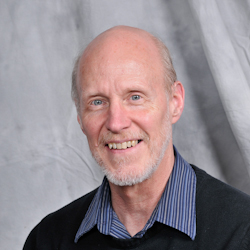 By Nic Baker
By Nic Baker
Clean Energy Committee member Dale Lutz says that of the many projects he’s been involved in, his current favorite is investigating how to wean ourselves off fossil fuel by “recycling” CO2 greenhouse gas and combining it with water and low-carbon renewable energy, like electricity from wind and solar. He recently took time to explain, in layperson’s terms, how this works.
Capture, Not Burn
The process is similar to what plants do. During photosynthesis, plants store the energy of sunlight by combining CO2 from the air with water to make hydrocarbons like sugars, releasing oxygen in the process. When the plants need energy to grow, they use the process of respiration to combine the sugars with oxygen from the air, releasing the energy and rearranging the atoms back into CO2 and water vapor. These processes of photosynthesis and respiration form a “carbon cycle” that helps balance the amount of CO2 greenhouse gas in the atmosphere.
To help bring the carbon cycle back into balance, we are working toward industrial scale “artificial photosynthesis”, in which we would first capture “waste” CO2 from a point source, such as an ethanol plant, a fossil-fuel power plant, a cement plant, or a steel mill. Then we would use low-carbon renewable electricity in devices called “electrolyzers” to combine the CO2 with water to produce the hydrocarbon fuels and chemicals that society will continue to need for airplane fuel, heating fuel, polymer fabrics, etc.
These electrolyzers can be quickly ramped up and down in power, to match the fluctuations of wind and solar power, thus helping stabilize the electrical grid. Any “excess” renewable energy can be diverted to these electrolyzers to store the summer sunshine as hydrocarbons, some of which could be used for winter heating fuel. For example, making methane (“synthetic natural gas”) that can be stored in the existing natural gas pipeline system. That way, we can leave all the “fossil fuels” underground and recycle the carbon that is already above ground to meet our needs.
Years ago, a chemist wrote that “the challenge of this generation will be learning to live off the sun in real time” rather than digging up and burning the last 500 million years’ worth of “fossil sunshine” that has been buried and stored as coal and oil.
A Background in Chemistry and a Concern for the Environment
Dale was an undergraduate chemistry major during the Vietnam War. He joined the Navy, teaching at the Navy Nuclear Power School. Upon discharge, he went to graduate school in physical chemistry at Stanford and took a postdoc position in analytical chemistry at University of Wisconsin - Madison.
He joined 3M 37 years ago, working in the Graphics Research Laboratory, then moved to the Fiber Optics Laboratory. He eventually became a patent liaison, teaming with lab inventors, business managers, and patent attorneys developing new products. Now, as an Intellectual Property Liaison, he is involved in numerous sustainability and energy-related projects at 3M, including the CO2 recycling efforts described above. He is also a member of the 3M Technical Forum Climate Chapter steering committee.
Dale initially became interested in the environment as a young child, growing up in a farming community, when his father took him on outdoors activities like hunting and fishing. His father was his Cub Scout leader and Dale has served as a Cubmaster and Boy Scout Troop committee member for his son, taking troop members on camping trips to help develop their outdoor and leadership skills.
Like his mother, Dale also loved watching animals, both wildlife and their various pets. He was disheartened reading about the extinctions of the passenger pigeons, great auks, dodos, and many others. We are now in the 6th mass extinction in earth’s history, and climate change is a major contributor. That is another motivation for Dale’s current work.
His interest in environmental issues became focused when he took an ecology class in college. He learned about the steady buildup of CO2 in the atmosphere and came to recognize early on the potential damage caused by global warming. Seeing the movie An Inconvenient Truth in 2007 “convinced me that I had to do something, and that we should have started 20 years earlier”, Dale said.
This focus has informed much of his work since.
In 2007, the Sierra Club sent him an invitation to participate in Earth Day. He volunteered to help, then became involved with the Clean Energy Committee. He has been a regular member of the committee ever since.
When asked what gives him hope, Dale responded, “My grandsons, and the people I’m working with on the CO2 recycling project.”
Dale lives in south Maplewood with his wife Linda. He has two adult children: a son who is teaching chemistry at Anoka-Ramsey Community College, and a daughter who is a high school social studies and government teacher in Michigan.
If you would like to learn more about Dale and the project he’s currently working on, he can be reached at drlutz@msn.com.